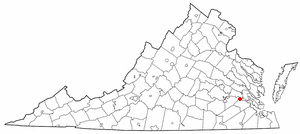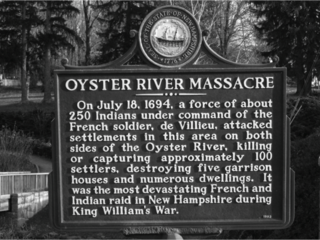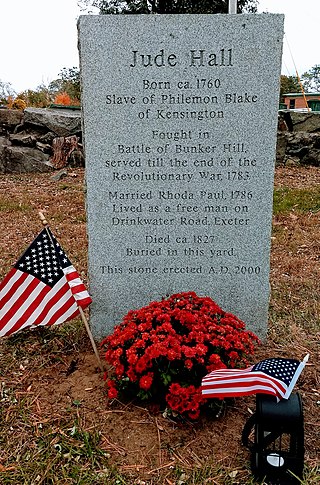
Claremont is an incorporated town in Surry County, Virginia, United States. The population was 378 at the 2010 census. A granite marker is a memorial to British settlers' arrival in the area. It received its name during the colonial era from the royal residence in Surry Shire in England. The town was incorporated in 1886, had a port on the James River, and gained railroad service as a terminus for a while before being abandoned. Claremont was home to the Temperance, Industrial, and Collegiate Institute, a school for African Americans founded by a formerly enslaved person. The area includes a historical marker commemorating the institution.

Ambrose Powell Hill Jr. was a Confederate general who was killed in the American Civil War. He is usually referred to as A. P. Hill to differentiate him from Confederate general Daniel Harvey Hill, who was unrelated.

Jane McCrea was an American woman who was killed by a Native American warrior serving alongside a British Army expedition under the command of John Burgoyne during the American Revolutionary War. Engaged to a Loyalist officer serving under Burgoyne, her death led to widespread outrage in the Thirteen Colonies and was used by Patriots as part of their anti-British propaganda campaign.
Lewis Wetzel was an American scout and frontiersman. Because of how feared he was by the Native American Tribes, he was nicknamed "Death Wind". He stood about 6 ft with dark brown hair. He was an expert with a knife and tomahawk and was even deadlier with a black powder rifle, or musket. While running at full speed, Death Wind could load powder from his powder horn, a ball round and pack it, aim it and fire with expert marksmanship every time. Raised in what is now the Northern Panhandle of West Virginia, his exploits were once hailed as similar to those of Daniel Boone.

Benjamin Logan was an American pioneer, soldier, and politician from Virginia, then Shelby County, Kentucky. As colonel of the Kentucky County, Virginia militia during the American Revolutionary War, he was second-in-command of all the trans-Appalachian Virginia. He became a politician and help secure statehood for Kentucky. His brother, John Logan, who at times served under him in the militia and replaced him as delegate, became the first state treasurer of Kentucky.
The Killough massacre is believed to have been both the largest and last Native American attack on white settlers in East Texas. The massacre took place on October 5, 1838, near Larissa, Texas, in the northwestern part of Cherokee County. There were eighteen victims, including Isaac Killough, Sr., and his extended family. They had immigrated to the Republic of Texas from Talladega County, Alabama, in 1837.

Captain Abraham Flowers Lincoln was the paternal grandfather and namesake of the 16th U.S. president, Abraham Lincoln. Lincoln was a military captain during the American Revolution, and a pioneer settler of Kentucky. Some historical sources attest his last name as Linkhorn, although neither Abraham nor his children ever signed themselves as such.

Prickett's Fort State Park is a 188-acre (76.1 ha) West Virginia state park north of Fairmont, near the confluence of Prickett's Creek and the Monongahela River. The park features a reconstructed refuge fort and commemorates life on the Virginia frontier during the late 18th century.

Pigeon Roost State Historic Site is located between Scottsburg and Henryville, Indiana, United States. A one-lane road off U.S. Route 31 takes the visitor to the site of a village where Native Americans massacred 24 settlers shortly after the War of 1812 began.

The Battle of Red Bank, also known as the Battle of Fort Mercer, was fought on October 22, 1777, during the American Revolutionary War. A British and Hessian force was sent to take Fort Mercer on the New Jersey side of the Delaware River just south of Philadelphia, but was defeated by a smaller force of Continental Army troops.

The Red Bank Battlefield is located along the Delaware River in National Park, Gloucester County, New Jersey. It was the location of the Battle of Red Bank in the American Revolutionary War on October 22, 1777. Fort Mercer and its sister, Fort Mifflin in Pennsylvania, defended the river and prevented the British from using it for transportation. The forts successfully delayed the British, but in the end, they were both destroyed or abandoned.

The Yellow Creek massacre was a killing of several Mingo Indians by Virginian settlers on April 30, 1774. The massacre occurred across from the mouth of the Yellow Creek on the upper Ohio River in the Ohio Country, near the current site of the Mountaineer Casino, Racetrack and Resort. It was the single most important incident contributing to the outbreak of Lord Dunmore's War. It was carried out by a group led by Jacob Greathouse and Daniel Greathouse. Daniel Greathouse died of measles the following year, and Jacob Greathouse was killed in an ambush in 1777. The other perpetrators were never brought to justice.

Argyle is a town in Washington County, New York, United States. It is part of the Glens Falls Metropolitan Statistical Area. The town population was 3,644 at the 2020 census. The town was named by its many early settlers from Scotland after Argyllshire.

The Raid on Oyster River, also known as the Oyster River Massacre, happened during King William's War, on July 18, 1694, when a group of Abenaki and some Maliseet, directed by the French, attacked an English settlement at present-day Durham, New Hampshire.
The Sugarloaf massacre was a skirmish which occurred on September 11, 1780, in the U.S. state of Pennsylvania when a number of Natives and a handful of Loyalists attacked a small detachment of militia from Northampton County. According to pension files and witness depositions, the militia detachment was led by Lieutenants John Moyer and John Fish of Captain Johannes Van Etten's company of volunteers.

The Great Hanging at Gainesville was the execution by hanging of 41 suspected Unionists in Gainesville, Texas, in October 1862 during the American Civil War. Confederate troops shot two additional suspects trying to escape. Confederate troops captured and arrested some 150–200 men in and near Cooke County at a time when numerous North Texas citizens opposed the new law on conscription. Many suspects were tried by a "Citizens' Court" organized by a Confederate military officer. It made up its own rules for conviction and had no status under state law. Although only 11% of county households enslaved people, seven of the 12 men on the jury were enslavers.

The Fort Vengeance Monument Site is an archaeological and commemorative site on United States Route 7 in northern Pittsford, Vermont. The site includes the archaeological remains of one of Vermont's oldest documented homesteads, and the only surviving site of a military fortification of the American Revolutionary War. The site is marked by a stone memorial placed in 1873, and was listed on the National Register of Historic Places in 2006.

Fort Wicked was a ranch and stage station on the Overland Trail from 1864 to 1868 in present-day Merino, Colorado. A historical marker commemorating the ranch is located at US 6 and CR-2.5. The ranch itself was located near a ford of the South Platte River, near where US-6 now crosses over the river. Fort Wicked was one of the few places along the trail to Denver that withstood an attack by Lakota (Souix), Cheyenne, and Arapaho Native Americans (Indians) in the Colorado War of 1864. It was named Fort Wicked for the "bitter defence" made by Holon Godfrey, his family, and his employees.

Jude (Judas) Hall was an African-American soldier in the American Revolutionary War. He served from 1775 to 1783, one of the longest serving soldiers either Black or white, and earned his freedom from slavery. After the war, he married and settled in Exeter, New Hampshire, where his homestead is still known as Jude's Pond. Three of his children were kidnapped and sold into slavery, and two of his grandsons fought in the American Civil War.

The Moses Kill is an approximately 22.0-mile-long (35.4 km) tributary stream of the Hudson River in New York state. The source is in the foothills of the Taconic Mountains in Hartford in Washington county. The stream flows thru the town and village of Argyle before entering the Hudson River at Fort Edward, just south of Griffin Island.

















